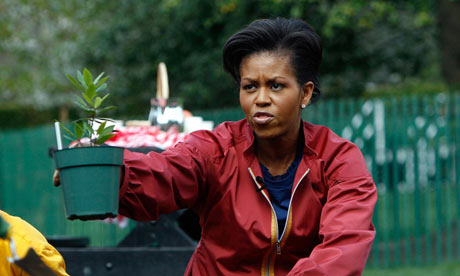Michelle Obama plants herbs and vegetables in the White House food garden. Photograph: Aude Guerrucci/AFP
The quiet revolution spreading steadily across the US in the way Americans produce and consume food
is about to acquire a powerful endorsement in the form of a farmers’
market planned for one of the better-known corners of the capital. It
will be sited a block away on the north side of a large white house and
will have the backing of its occupier, one Michelle Obama.
The
plan is the latest building block in the movement the first lady has
been seeking to build over food and health since she entered the White
House in January. Though her office is refusing to engage with media
speculation, the telltale signs are there that she plans to extend her
campaign – launched in March with the opening of a food garden in the
White House grounds – by backing a farmers’ market just a stone’s throw
from her presidential home.
Excitement levels among web-savvy
organic food enthusiasts went through the roof today in anticipation.
It was disclosed that an application had been made to the local city
authorities in Washington DC to close Vermont Avenue on the north flank
of the White House to traffic on Thursday afternoons for six weeks
until the end of October.
The application has been made in the
name of a local non-profit group Fresh Farm Markets. Telltale sign
number one was that Sam Kass, who has worked as the Obamas’ personal
chef in Chicago and now advises Michelle on her White House food
garden, turned up at public meetings to back the proposal.
Telltale
sign number two was that the city authorities have let it be known that
Fresh Farm Markets is in cahoots with Obama. “It is our understanding
that the group is working with the White House,” John Lisle of the
city’s transportation department said.
Sign three: Barack Obama‘s
comment last month that his wife was looking at a little market nearby.
“I’m not going to have all y’all just tromping around – but right
outside the White House,” he said.
The first lady’s passion for
healthy eating began, she has said, in the early stages of the
gruelling two-year presidential election campaign that her family
endured. “We started to see that taking a toll on our health,” she
said. “Our children’s paediatrician gave me a little tap on the
shoulder and said you might want to make some changes.”
She
eradicated processed foods and concentrated on a simple diet in
moderation. Her concern for her own family led to a wider interest in
the obesity epidemic that has a fifth of all American children in its
grip. Having moved into the White House, and with a little prodding
from organic advocates such as Alice Waters, the chef of Chez Panisse
in Berkeley, California, she decided to turn over a little over 93 sq
metres (1,000 sq ft) of the South Lawn to fruit and vegetables.
Six
months on and the garden, Michelle Obama has said, is “beautiful; it is
blooming; it is bursting”. More than 50 varieties of vegetables are
grown, including rhubarb, tomatoes, peppers, spinach, okra and
aubergines. Of the 225lbs of food grown so far, some has gone to what
Obama calls “big fancy luncheons” at the White House, some to her
children, and some to homeless people at Miriam’s Kitchen, a local
shelter.
Her objective is clearly to take some of that mass
obsession with her own health and fitness, and project it on the
American population at large. And it appears to be working. “Her action
of planting an organic garden on the White House lawn for all to see
speaks louder than words, and it’s having an impact,” said Lisa Bunin
of the Centre for Food Safety.
Ronnie Cummins of the Organic
Consumers Association said they were looking to Obama to be the
“farmer-in-chief”. His group petitioned her with 100,000 signatures to
set up the White House food garden, prompting counter-efforts from the
pesticide and agribusiness sector which took out advertisements saying
Obama’s organic push was ill-advised. But Michelle Obama is not one to
give up easily. As she told a class of children who came to dig the new
plot: “We did a lot of work moving that dirt. That was harder than I
thought. That stuff was heavy, wasn’t it?”

